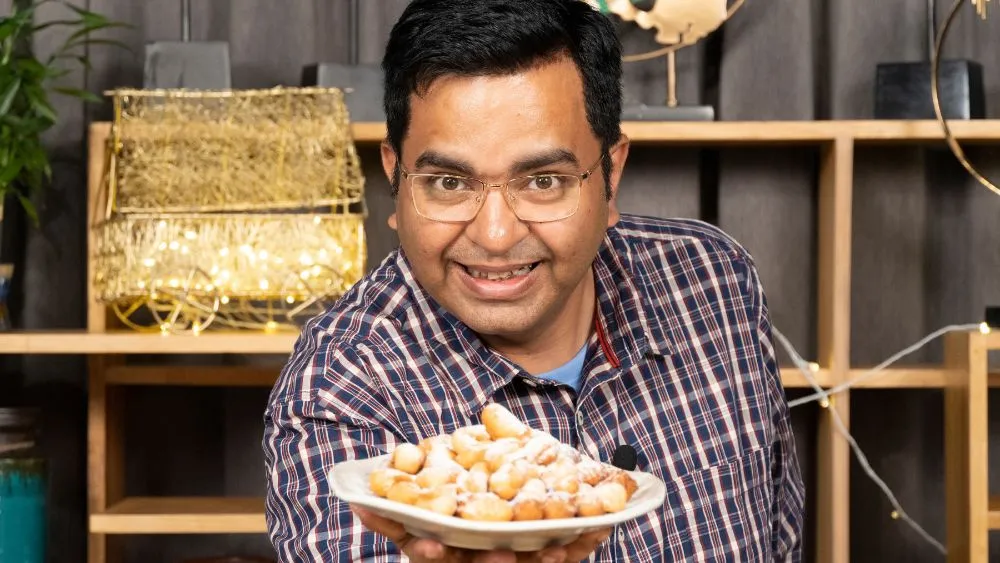
Christmas Special Kulkuls Recipe

20min

2-3 people

10 mins
Introduction
Ah, the festive season of Christmas brings back memories of warmth, joy, and of course, delicious treats! One tradition that always stands out during this time is the preparation of Christmas goodies. Among the array of delightful sweets and snacks, there's one particular delicacy that holds a special place in my heart - Kulkuls. Let me take you on a journey to discover the magic of this traditional Christmas treat.
I remember as a child, eagerly awaiting the arrival of Christmas not just for the presents and decorations, but also for the delightful aroma of Kulkuls wafting through the air. The process of making Kulkuls was a cherished tradition in our household, where the entire family would come together to prepare these bite-sized delights. Rolling the dough into tiny curls and frying them to perfection was not just a culinary experience but a bonding moment that brought us closer as a family.
Recipe of Christmas Special Kulkuls
Portions serving: 6-7 pax
Preparation time: 10 mins
Cooking time: 40 mins
Calories: 143 cal per portion
Ingredients:
- Flour – 1 cup
- Semolina – ½ cup
- Powdered sugar – 2 tbsp
- Salt – ½ tsp
- Ghee – 1 tbsp
- Coconut milk – 1 cup
Method:
Preparing the Dough:
- In a mixing bowl, combine the flour, semolina, powdered sugar, and salt. Mix well to ensure even distribution of the dry ingredients.
- Add ghee to the dry mixture. Ghee adds richness and enhances the flavour of the kulkuls.
- Pour coconut milk into the bowl. Coconut milk not only acts as a binding agent but also imparts a delicate coconut flavour to the kulkuls.
- Using your hands, knead all the ingredients together to form a smooth and pliable dough. Ensure that the dough is not too sticky or too dry. Adjust the consistency by adding more flour or coconut milk if needed.
Shaping the Kulkuls:
- On a clean chopping board or any smooth surface, take small portions of the dough and roll them into small balls.
- Now, take a fork and use its tines to create the classic kulkul shape. Place a small ball of dough on the fork and gently roll it with your finger to create a textured pattern on the surface of the kulkul.
Finishing:
- In a nonstick pan, heat oil for frying the kulkuls. Ensure that the oil is heated over low to medium flame to avoid burning or uneven frying.
- Carefully slide the shaped kulkuls into the hot oil. Fry them in batches to prevent overcrowding and to ensure even frying.
- Fry the kulkuls until they turn a beautiful golden brown colour. The slow frying process will help achieve a crispy texture and evenly cooked interior.
- Once the kulkuls attain the desired colour, use a slotted spoon to remove them from the hot oil. Place them on a plate lined with absorbent paper to drain any excess oil.
- Allow the kulkuls to cool down slightly before serving.
About the Recipe
Now, let's delve into what makes Kulkuls so special. These sweet, crispy treats are a staple in Goan and Mangalorean households during the Christmas season. Made from a simple dough of flour, semolina, sugar, and coconut milk, Kulkuls are shaped into small curls resembling shells or horns before being deep-fried to golden perfection. The addition of coconut milk lends a rich and fragrant flavor to the dough, while the frying process gives them a satisfying crunch. Kulkuls are often enjoyed as a festive snack or dessert and are perfect for gifting to friends and family during the holiday season.
Cooking Tips
1. Dough Consistency
Achieving the right consistency of the dough is crucial for perfect Kulkuls. It should be firm yet pliable enough to shape into curls. Add more flour or coconut milk as needed to achieve the desired texture.
2. Shaping the Kulkuls
Take small portions of dough and roll them into small balls. Using a fork or a special Kulkul roller, gently press and roll the dough to create the characteristic curled shape. Ensure that the curls are tight to prevent them from unraveling during frying.
3. Frying Temperature
Maintain a consistent frying temperature to ensure that the Kulkuls cook evenly and attain a uniform golden brown color. Fry them in batches, if necessary, to avoid overcrowding the pan.
4. Sweetening the Dough
Adjust the amount of sugar according to your taste preferences. You can also add flavorings like cardamom powder or nutmeg for an extra layer of flavor.
Pairing Guide
Kulkuls are best enjoyed with a hot cup of tea or coffee, allowing you to savor their sweet and crispy goodness. They also make a delightful accompaniment to other festive sweets like Gujiyas or Mithai.
Frequently Asked Questions about Kulkuls
-
What are Kulkuls made of? Kulkuls are made from a dough consisting of flour, semolina, sugar, and coconut milk.
-
Can I make Kulkuls ahead of time? Yes, you can prepare the dough for Kulkuls in advance and store it in the refrigerator. Shape and fry them just before serving to ensure maximum freshness and crunchiness.
-
How long do Kulkuls stay fresh? When stored in an airtight container, Kulkuls can stay fresh for up to two weeks. However, they are best enjoyed within a few days of preparation for optimal flavor and texture.
-
Can I freeze Kulkuls? While it's possible to freeze Kulkuls, it may affect their texture. It's recommended to enjoy them fresh for the best taste and crunch.
-
Are Kulkuls vegan-friendly? Traditional Kulkuls are not vegan-friendly as they contain dairy in the form of coconut milk. However, you can explore vegan alternatives by using plant-based milk and substitutes for butter or ghee.
-
Can I add nuts to Kulkuls? Yes, you can add chopped nuts like almonds, cashews, or pistachios to the dough for added texture and flavor.
-
How do I store leftover Kulkuls? Store leftover Kulkuls in an airtight container at room temperature to maintain their crispiness. Avoid exposing them to moisture to prevent them from becoming soggy.
-
What is the origin of Kulkuls? Kulkuls have their roots in Goan and Mangalorean cuisine and are traditionally prepared during Christmas festivities.
-
Can I make Kulkuls without coconut milk? While coconut milk adds richness and flavor to Kulkuls, you can explore alternatives like regular milk or almond milk if you have dietary restrictions or preferences.
-
What is the significance of Kulkuls in Christmas celebrations? Kulkuls are a symbol of joy and togetherness during Christmas festivities, often prepared as a family bonding activity and shared with loved ones as a gesture of goodwill and happiness.
